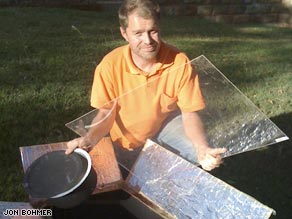Or at least for the life of the equipment. (it’s jam band friday – http://www.youtube.com/watch?v=fhNrqc6yvTU)
I mean this is the ultimate irony in the utility world. Heating water with anything other than the sun which is free is a crime. I mean think about it. Why? First the Tax Credit
Not there silly here:
http://www.energystar.gov/index.cfm?c=products.pr_tax_credits#s11
| Solar Energy Systems | Solar Water Heating | At least half of the energy generated by the “qualifying property” must come from the sun. Homeowners may only claim spending on the solar water heating system property, not the entire water heating system of the household.The credit is not available for expenses for swimming pools or hot tubs.The water must be used in the dwelling.The system must be certified by the Solar Rating and Certification Corporation (SRCC). | 30% of cost | All ENERGY STAR solar water heaters qualify for the tax credit.Use IRS Form 5695 |
:}
( http://www.youtube.com/watch?v=LANwIgpha7k )
No pools or hot tubs dam nit…we can’t have everything being free. So these things come in all shapes and sizes:
http://www.energysavers.gov/your_home/water_heating/index.cfm/mytopic=12850
Solar Water Heaters
Solar water heaters—also called solar domestic hot water systems—can be a cost-effective way to generate hot water for your home. They can be used in any climate, and the fuel they use—sunshine—is free.
How They Work
Solar water heating systems include storage tanks and solar collectors. There are two types of solar water heating systems: active, which have circulating pumps and controls, and passive, which don’t.
Most solar water heaters require a well-insulated storage tank. Solar storage tanks have an additional outlet and inlet connected to and from the collector. In two-tank systems, the solar water heater preheats water before it enters the conventional water heater. In one-tank systems, the back-up heater is combined with the solar storage in one tank.
Three types of solar collectors are used for residential applications:
-
Flat-plate collector
Glazed flat-plate collectors are insulated, weatherproofed boxes that contain a dark absorber plate under one or more glass or plastic (polymer) covers. Unglazed flat-plate collectors—typically used for solar pool heating—have a dark absorber plate, made of metal or polymer, without a cover or enclosure.
-
Integral collector-storage systems
Also known as ICS or batch systems, they feature one or more black tanks or tubes in an insulated, glazed box. Cold water first passes through the solar collector, which preheats the water. The water then continues on to the conventional backup water heater, providing a reliable source of hot water. They should be installed only in mild-freeze climates because the outdoor pipes could freeze in severe, cold weather.
-
Evacuated-tube solar collectors
They feature parallel rows of transparent glass tubes. Each tube contains a glass outer tube and metal absorber tube attached to a fin. The fin’s coating absorbs solar energy but inhibits radiative heat loss. These collectors are used more frequently for U.S. commercial applications.
There are two types of active solar water heating systems:
-
Direct circulation systems
Pumps circulate household water through the collectors and into the home. They work well in climates where it rarely freezes.
-
Indirect circulation systems
Pumps circulate a non-freezing, heat-transfer fluid through the collectors and a heat exchanger. This heats the water that then flows into the home. They are popular in climates prone to freezing temperatures.
:}
( http://www.youtube.com/watch?v=uLlOTPBBq9k )
Still you must decide:
http://www.solardirect.com/swh/swh.htm
Solar Water Heating Systems
All solar water heaters work in every climate, but different types of heaters work best in different areas, see below:
|
Need help or want a Fully Installed System?
We have over 35,000 satisfied customers served since 1986!
Solar Direct has over 25 years of experience in commercial and
residential solar hot water product installation. Services are available
throughout the U.S. with our national installer network.
Contact Us for installation and product information, our team of Product Solution Specialists are standing by to take your calls.
 Solar Water Heating technologies are a simple, reliable, and cost-effective harnessing the sun’s energy to provide for the solar thermal energy needs of homes and businesses. And now the new Energy Policy Act of 2005 allows you receive a federal tax credit worth 30% of the system cost! This is the best time to reap the numerous benefits of solar power!
Solar Water Heating technologies are a simple, reliable, and cost-effective harnessing the sun’s energy to provide for the solar thermal energy needs of homes and businesses. And now the new Energy Policy Act of 2005 allows you receive a federal tax credit worth 30% of the system cost! This is the best time to reap the numerous benefits of solar power!
- Financial solar rebates available
- Easy Do-It-Yourself Kits
- Professional Solar Installations
- Low Investment – High Return
- Savings pay for system in 3-5 years
:}
So what are you waiting for?
( http://www.youtube.com/watch?v=jeJeL8Ued3s&feature=related )
:}


 Heat pumps have traditionally been used for space conditioning, but are now also being used for electric water heating. They are usually three times more efficient than electric resistance water heaters–meaning that they can produce the same amount of hot water for one-third the amount of electricity. Stand-alone heat pump water heaters (HPWH), which are described here, are different from heating and cooling heat pump systems that have integrated water-heating capability.
Heat pumps have traditionally been used for space conditioning, but are now also being used for electric water heating. They are usually three times more efficient than electric resistance water heaters–meaning that they can produce the same amount of hot water for one-third the amount of electricity. Stand-alone heat pump water heaters (HPWH), which are described here, are different from heating and cooling heat pump systems that have integrated water-heating capability.



